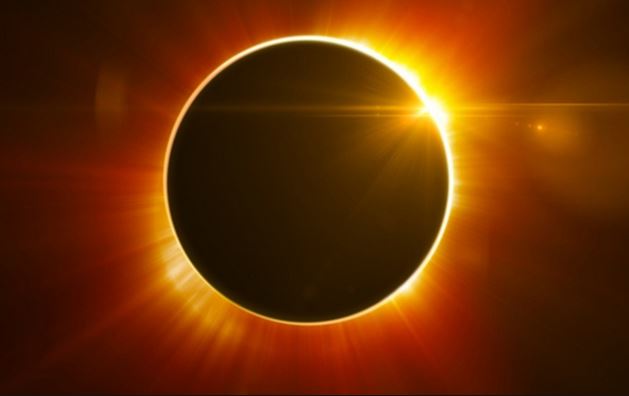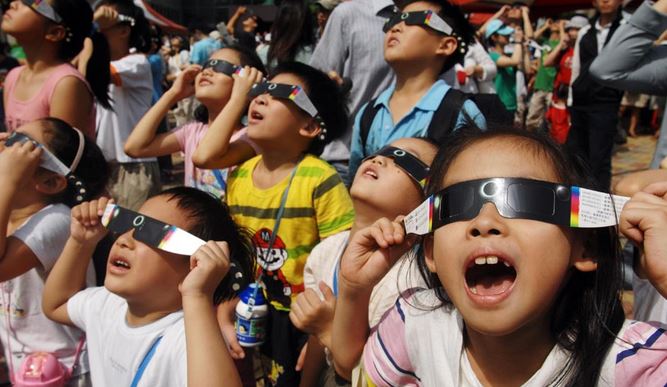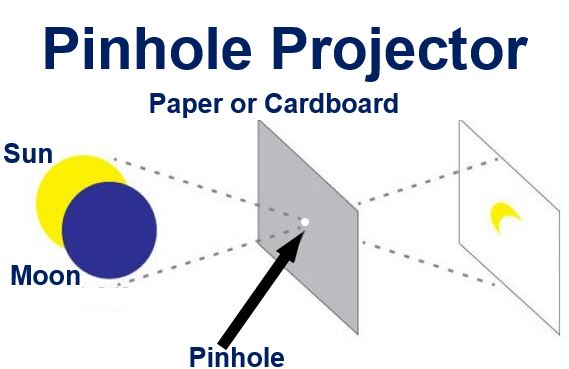People across the UK will be able to view a Supermoon and a solar eclipse virtually at the same time, which the Met Office says is called a Supermoon Eclipse. The rare event occurs when the Earth and Moon are near to each other as they can be (Supermoon), plus there is a solar eclipse.
On March 20th, the far north of the UK will experience 98% obscuration (darkness), while the far south will have 85%. Scientists remind people who want to enjoy the experience to take safety measures to protect their eyes – don’t look at the eclipse directly with the naked eye. You run the risk of eyesight damage and even blindness if you do!
Most of Europe, western and northern Africa, and northern Asia will go dark on March 20th. There will be a total eclipse (100% obscuration) in the Faroe Islands, an archipelago between Norway and Iceland.

On Friday morning, March 20th, the whole of Europe will go dark.
When the Moon comes in between the Sun and the Earth there is a solar eclipse. The Moon blocks out the Sun’s light.
During a solar eclipse the Moon casts two shadows on the surface of Earth: 1. The small umbra, where there is total darkness. 2. The larger penumbra, which brings partial darkness.
The UK will be covered by the penumbra.
According to the Met Office, the total eclipse in the Faroe Islands will last 2 minutes and 24 seconds. The UK’s partial eclipse will start at 07:41 GMT and end at 11:50 GMT. The next one won’t come until August 11th, 2026, astronomers say, so make the best!
The British Astronomical Association (BAA) wrote:
“An obvious partial eclipse will be visible from every country in Europe and the partial phase will also be seen from places as widely spread as Newfoundland, North Africa and north-western Asia.”
The Isle of Lewis, part of the Outer Hebrides in Scotland, will boast the highest level of obscuration (98%) in the UK.

Special solar eclipse glasses should filter out 100% of ultra-violet, 100% of infrared, and 99.999% of intense visible light. Europeans should make sure they have the CE marking, which means the product complies with European Union regulations.
Enjoy the solar eclipse safely
Regarding safety measures during a solar eclipse, the US space agency NASA says:
“The Sun can be viewed safely with the naked eye only during the few brief seconds or minutes of a total solar eclipse. Partial eclipses, annular eclipses, and the partial phases of total eclipses are never safe to watch without taking special precautions.”
“Even when 99% of the Sun’s surface is obscured during the partial phases of a total eclipse, the remaining photospheric crescent is intensely bright and cannot be viewed safely without eye protection.”
The BAA offers the following advice, from its Solar Eclipse Safety Code:
“DON’T view the Sun through sunglasses of any type (single or multiple pairs), or filters made of black & white or colour photographic film, or any combination of photographic filters, crossed polarisers or gelatin filters, CDs, CD-ROMs, or smoked glass. These are NOT safe.”
“DO view the Sun ONLY through special filters made for safe solar viewing, e.g. aluminised mylar filters, or black polymer filters, identified as suitable for direct viewing of the Sun, bearing the CE mark AND a statement that it conforms to European Community Directive 89/686/EEC, or use a welder’s glass rated at No. 14 or higher. Always read and follow the manufacturer’s instructions carefully.”
Adults need to make sure children are supervised if they want to enjoy the experience. Kids are more likely than older people to look directly at the eclipse, regardless of repeated warnings.
Make your own pinhole projector
A pinhole projector (pinhole camera) is an easy, safe and cheap way to watch an eclipse. You will see an inverted image of a partially-blocked sun.
All you need are two white sheets of paper and a pin. Make a small, smooth, round hole in the middle of one of the sheets with the pin.

Kids enjoy making and using a pinhole projector. (Help small children when using the pin)
Hold the sheet with the hole up, towards the sun, and the other sheet about two feet away. Move them about until you can see an inverted image of the Sun on the lower sheet.
While you do this stand with your back to the Sun to protect your eyes.
Solar power industry says it is ready
More electricity comes from solar power in Europe than anywhere else in the world. During the eclipse, the continent will lose about 35,000 MW of electricity, which is the equivalent to what eight medium-sized power stations can generate.
When everywhere goes dark, demand for power will rise, as people switch their lights on.
The European Network of Transmission System Operators for Electricity said in a statement:
“Managing this event on the world’s largest interconnected grid is an unprecedented challenge for European TSOs.”
“Solar eclipses have happened before but with the increase of installed photovoltaic energy generation, the risk of an incident could be serious without appropriate countermeasures, as was pointed out in ENTSOE’s Winter Outlook Report of last December.”
